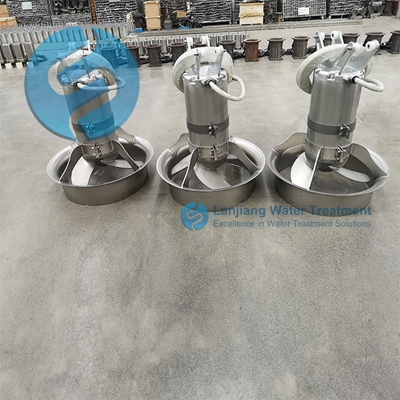When there is an overload situation in the sewage mixer, a series of measures should be taken to diagnose the problem, solve the problem and prevent future recurrence. Here are some specific steps and suggestions:
First, stop the machine immediately for inspection
1. Cut off the power supply: First of all, the power supply of the mixer must be cut off immediately to prevent further damage caused by the motor continuing to run.
Second, overload cause investigation
1. Stirrer rotation flexibility: Check whether the stirrer rotates flexibly, and the stirrer may be contaminated and worn after long-term use, resulting in increased rotation resistance and increased motor load.
2. The mixer is blocked: check whether the material is solidified and adhered to the mixer during the mixing process, causing the mixer to be blocked.
3. Voltage stability: Use a voltmeter to check whether the power supply voltage is stable, and too low or fluctuating voltage may also lead to motor overload.
4 motor itself failure: check whether the motor winding, bearings and other components are damaged or faulty, these failures may also cause overload.
5. Other mechanical problems: such as loose guide hood support, incorrect impeller size, excessive tightening of stuffing box, etc., may also lead to mixer overload.

Third, take measures to solve the problem
1. Cleaning the agitator: clean the inside and outside of the agitator regularly to avoid pollution and wear and ensure that the agitator rotates flexibly.
2. Prevent the mixer from being blocked: During the mixing process, lubricating oil, water and other substances can be added appropriately to prevent the material from adhering to the mixer. At the same time, check and clean the attachments on the mixer regularly.
3. Stable voltage: Install a regulator or use a stable power supply to ensure that the power supply voltage fluctuates within a reasonable range.
4. Repair or replace the motor: If the motor itself is faulty, professional and technical personnel should be asked to detect and repair in time. If the fault is serious and cannot be repaired, a new motor should be considered.
5, adjust the mechanical parts: for the guide hood bracket loose, impeller size is incorrect and other problems, should be adjusted or replaced in time. Ensure all mechanical components are properly installed and securely secured.
Fourth, preventive measures
1. Regular maintenance: Develop a regular maintenance plan to check and maintain the various parts of the mixer to ensure that the equipment is in good condition.
2. Operation specifications: Train operators to ensure that they understand the correct operation methods and safety precautions of mixers to avoid equipment overload due to improper operation.
3. Monitoring operating status: Install operating status monitoring equipment, such as ammeter, voltmeter, etc., real-time monitoring of the operating status of the mixer, timely discovery and solution of problems.
Fifth, precautions
1. Safety first: When dealing with overload problems, it is necessary to ensure the safety of personnel and avoid dangerous situations such as electric shock.
2. Professional maintenance: For the maintenance and replacement of key components such as motors, professional and technical personnel should be asked to operate to ensure the maintenance quality and equipment performance.
Through the above steps and measures, the overload problem of the sewage mixer can be effectively treated and similar situations can be prevented in the future.
Post time:2024-07-08